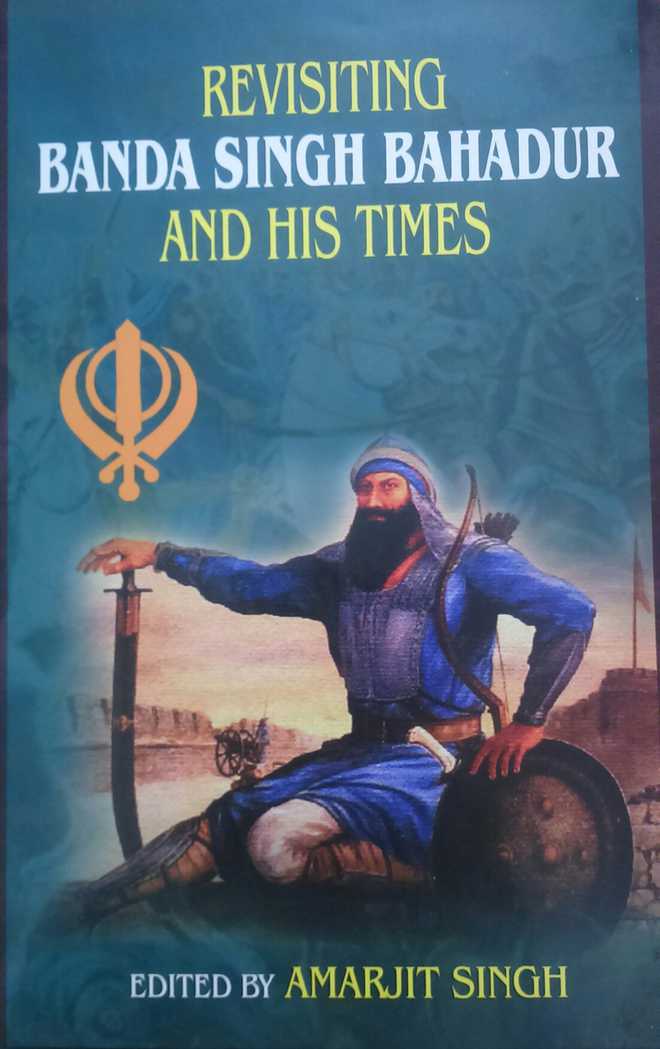A life steeped in myths and facts
Kuldip Singh Dhir
The year 2016 marks the tercentenary celebrations of Banda Singh Bahadur. The book Revisiting Banda Singh Bahadur and his Times comprises research papers on the life of great Sikh general presented at two seminars organised by Kurukshetra University at Kurukshetra. Historiography of Banda is diverse and rich.
Contemporary Mughal court historians and chroniclers of their ilk seem to be clearly biased if we see the tone and tenor of their narrative. They abuse and criticise Banda for alleged cruelty and barbarism. Khafi Khan, Ghulam Hussain Khan, Ghulam Mohy-ud-din, Muhammad Qasim, Mirza Muhammad Harsi, Muhammad Shaffi Warid and Muhammad Qalandar Yar, all fall in this category. Sikh historians of early 19th century also vilified Banda. Some of them were ill-informed, while others condemned him only to glorify their ancestors who betrayed Banda.
Sarup Das Bhala seems to lead the charge. Poetic historiography of Kesar Singh Chhiber, Rattan Singh Bhangu, Bhai Santokh Singh and Giani Gian Singh based on hearsay also results in unreliable and exaggerated account. It seems like without interrogating the available texts or sources, they dished out their own versions. Then there is Muhammad Latif, another 19th century historian, who painted Banda as anti-Muslim fanatic bent upon massacring to avenge the death of the father and sons of Guru Gobind Singh.
British historians of 19th and early 20th century had their own agenda of dividing the country on the basis of religion and culture. Payne, Wheeler, Browne, Forester, Malcolm, Mc Gregor, Elphinistone, Thorton, Cunningham and lrvine, all tread, more or less the same path. However, they ipso facto, have highlighted his courageous struggle against the oppressive state, his military genius, formation of the first sovereign Sikh state, his agenda of reforms, his heroic martyrdom and his legacy.
It can be concluded that the socio-political climate of the 18th and 19th centuries was not conducive for an objective and analytical study of Banda. It was only in the 20th century that objective assessment of Banda with the modern historical tools and methodology was taken up. Ganda Singh, Fauja Singh, HR Gupta, JS Grewal, Irfan Habib and Muzaffar Alam researched further.
The enormity and diversity of literature on Banda, coupled with surfacing of new sources, provides opportunities to reassess and revisit Banda and his times and this is what has been attempted in these papers. The scholars have scanned the vast source material to reconstruct the image of Bairagi Madho Das, a celibate recluse, into a socially and politically committed Sikh, faithful to his master till his martyrdom.
Sukhdev Singh has made an incisive study of Latif's account. He concludes that Latif failed to assess the character of the Sikh movement under Banda. Veena Sachdeva has briefly outlined the history of seven-year-long confrontation between Banda and the Mughal state. She underlines the fact that Banda was continuously at war with the state. He was either occupying new territories or trying to regain control of these.
Jaspal Kaur Dhanju has analysed Fatuhat Nama-i-Samadi's treatment of Banda. Sukhdial Singh accuses Sarup Dass Bhalla of sullying Banda's image to justify the deeds of Binod Singh and Kahn Singh of his Bhalla clan, who betrayed Banda. He rubbishes Bhangu's account of Banda as based on hearsay and rumours and terms that of Bhai Santokh Singh and Karam Singh as unreliable.
Sulakhan Singh has examined the schism between Bandai Sikhs and the Tat Khalsa which is at the root of several controversies about Banda. Nazer Singh has done elaborated research work on Banda since 1934 with his thought-provoking meta-critical comments.
Two papers in this volume deserve special mention because of new source material and insights regarding Banda's dreams to free the country from tyrannical Mughal empire by forging new alliances. The two scholars have given documentary proofs of Banda's overtures and correspondence which they have adduced from court vakils of rajas of Jaipur and Jodhpur as well as from Akhbar-i-Darbar-I-Mualla. Dilbagh Singh concludes that court vakils of the rajas advocated friendly terms with the Sikhs. The rajas did not take any hasty decisions and pedaled soft under pressure to join imperial campaign against Banda.
Balwant Singh Dhillon has gone further to examine the diplomatic issue. He opines that Banda had entered into an understanding with the hill chiefs on the basis of his tactfulness and demonstration of power. It provided him easy access to shelter in hilly areas. He asserts that Banda took initiative to forge Sikh-Rajput alliance also. His initial success was a cause of concern for the Mughals who feared that he might escape to Rajasthan. Proposed alliance however failed to take off because of the indecisiveness and selfish interest of Rajput chiefs. The history really has its own lessons, but who cares!
Unlock Exclusive Insights with The Tribune Premium
Take your experience further with Premium access.
Thought-provoking Opinions, Expert Analysis, In-depth Insights and other Member Only Benefits
Already a Member? Sign In Now










